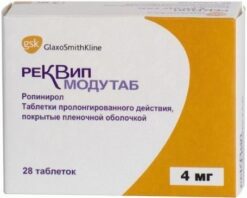No products in the cart.
Rekvip Modutab, 2 mg 28 pcs
€52.72 €45.69
Description
Requip Modutab is an antiparkinsonian drug, a highly selective non-ergoline agonist of dopamine D 2 -, D 3 -receptors, which has peripheral and central action. The drug does not act on disrupting presynaptic dopaminergic black matter neurons and acts directly as a synthetic neurotransmitter.
Thus, ropinirole reduces the degree of hypodynamia, rigidity and tremor, which are symptoms of parkinsonism. Ropinirole compensates for dopamine deficits in the black matter and striatum systems by stimulating dopamine receptors in the striatum.
Ropinirole enhances the effects of levodopa, including the control of on/off frequency phenomenon and “end-of-dose” effects associated with long-term therapy with levodopa drugs, and allows a reduction in the daily dose of levodopa. Ropinirole acts at the hypothalamic and pituitary levels by inhibiting prolactin secretion.
Pharmacokinetics
The pharmacokinetics of ropinirole are similar in healthy subjects, Parkinson’s patients and patients with restless legs syndrome and differ depending on the dosage form.
Intake.
The bioavailability of ropinirole after oral administration is low and is approximately 50% (36%-57%). After oral administration of ropinirole in slow release tablets its concentration in plasma increases slowly, the average time to reach the maximum concentration (Tmax) is 6 hours.
At equilibrium in patients with Parkinson’s disease after oral administration of 12 mg ropinirole once daily in combination with fat-rich food, an increase in systemic exposure of ropinirole was observed, with the increase of area under “concentration-time” curve (AUC) and maximum concentration (Cmax) by 20% and 44% respectively, Tmax was prolonged by 3 hours. However, in clinical studies of efficacy and safety ropinirole was taken regardless of food intake.
Binding to plasma proteins and distribution. Binding to plasma proteins is low (10-40%). Due to high lipophilicity ropinirole is characterized by high volume of distribution (approximately 7 l/kg).
Metabolism. Ropinirole is mainly metabolized by CYP1A2 isoenzyme.
The metabolite of ropinirole is mainly excreted by the kidneys.
Evacuation. On average, the elimination half-life of ropinirole from the systemic bloodstream is about 6 hours. The increase in the duration of systemic action of ropinirole (Cmax and AUC) is approximately proportional to the increase in dose. There is no difference in excretion of ropinirole after a single oral dose or with regular use.
Special patient groups
Elderly patients
The clearance of ropinirole after oral administration is reduced by approximately 15% in elderly patients aged 65 years and older compared to younger patients. No dose adjustment is required in this category of patients.
Patients with impaired renal function
Pharmacokinetic parameters are not changed in patients with mild to moderate renal impairment and Parkinson’s disease.
In patients with end-stage renal failure who are on permanent hemodialysis, oral ropinirole clearance is reduced by approximately 30%.
Indications
Indications
Parkinson’s disease:
Monotherapy in early stages of the disease in patients requiring dopaminergic therapy to delay the initiation of levodopa.
As a combination therapy in patients receiving levodopa, to improve the effectiveness of levodopa, including control of on-off and end-dose effects during chronic levodopa therapy, and to reduce the daily dose of levodopa.
Pharmacological effect
Pharmacological effect
Requip Modutab is an antiparkinsonian drug, a highly selective non-ergoline agonist of dopamine D 2 -, D 3 -receptors, which has peripheral and central effects. The drug does not act on decaying presynaptic dopaminergic neurons of the substantia nigra and acts directly as a synthetic neurotransmitter.
Thus, ropinirole reduces the degree of physical inactivity, rigidity and tremor, which are symptoms of parkinsonism. Ropinirole compensates for dopamine deficiency in the substantia nigra and striatal systems by stimulating dopamine receptors in the striatum.
Ropinirole enhances the effects of levodopa, including control of the frequency of the on/off phenomenon and the end-of-dose effect associated with long-term levodopa therapy, and allows for a reduction in the daily dose of levodopa. Ropinirole acts at the level of the hypothalamus and pituitary gland, inhibiting the secretion of prolactin.
Pharmacokinetics
The pharmacokinetics of ropinirole are similar in healthy subjects, patients with Parkinson’s disease and patients with restless legs syndrome and vary depending on the dosage form.
Suction.
The bioavailability of ropinirole after oral administration is low and is approximately 50% (36%-57%). After oral administration of ropinirole extended-release tablets, its plasma concentration increases slowly, the average time to reach maximum concentration (Tmax) is 6 hours.
At steady state, in patients with Parkinson’s disease, after oral administration of 12 mg of ropinirole once daily in combination with a meal rich in fat, an increase in the systemic exposure of ropinirole was observed, with an increase in the area under the concentration-time curve (AUC) and maximum concentration (Cmax) by 20% and 44%, respectively, Tmax was prolonged by 3 hours. However, in clinical studies of the effectiveness and safety of ropinirole, ropinirole was taken regardless of food intake.
Plasma protein binding and distribution. Plasma protein binding is low (10-40%). Due to its high lipophilicity, ropinirole has a large volume of distribution (approximately 7 l/kg).
Metabolism. Ropinirole is mainly metabolized by the CYP1A2 isoenzyme.
The metabolite of ropinirole is mainly excreted by the kidneys.
Excretion. On average, the half-life of ropinirole from the systemic circulation is about 6 hours. The increase in the duration of systemic action of ropinirole (Cmax and AUC) is approximately proportional to the increase in dose. There is no difference in the elimination of ropinirole after a single oral dose or with regular use.
Special patient groups
Elderly patients
Oral clearance of ropinirole is reduced by approximately 15% in elderly patients aged 65 years and older compared with younger patients. No dose adjustment is required in this category of patients.
Patients with impaired renal function
Pharmacokinetic parameters do not change in patients with mild to moderate renal impairment and Parkinson’s disease.
In patients with end-stage renal disease on chronic hemodialysis, the oral clearance of ropinirole is reduced by approximately 30%.
Active ingredient
Active ingredient
Ropinirole
Composition
Composition
Active ingredient:
ropinirole hydrochloride;
Excipients:
hypromellose-2208,
hydrogenated castor oil,
carmellose sodium,
povidone-K29-32,
maltodextrin,
magnesium stearate,
lactose monohydrate,
colloidal silicon dioxide,
mannitol,
iron [III] oxide (yellow) (E172),
glyceryl dibehenate
Pregnancy
Pregnancy
During pregnancy, it is possible if the expected effect of therapy exceeds the potential risk to the fetus.
FDA category of effect on the fetus is C.
Ropinirole inhibits prolactin secretion in humans and may potentially inhibit lactation. Animal studies have shown that ropinirole and/or its metabolites are excreted into the milk of lactating rats. It is not known whether ropinirole is excreted into human breast milk.
Since many drugs are excreted in a woman’s milk and ropinirole can cause serious adverse effects on the infant, a decision should be made to either stop breastfeeding or not take ropinirole (taking into account the degree of need for this medicine for the mother).
Contraindications
Contraindications
Hypersensitivity
Side Effects
Side Effects
From the side of the central nervous system: drowsiness, dyskinesia; hallucinations, dizziness (even severe); confusion, drowsiness, dizziness (even severe);
From the cardiovascular system: orthostatic hypotension, decreased blood pressure, orthostatic hypotension, decreased blood pressure;
From the digestive system: nausea, abdominal pain, dyspepsia, vomiting, constipation;
General reactions: peripheral edema (including swelling of the legs);
From the central nervous system and peripheral nervous system: psychotic conditions (including delirium and delirium), perception disorders (including illusions, excluding hallucinations), increased impulsivity, increased libido, including hypersexuality, pathological attraction to gambling; severe drowsiness, episodes of sudden falling asleep (as with other dopaminergic drugs, these symptoms have been very rarely recorded in patients with Parkinson’s disease). When the dose was reduced or the drug was discontinued, all symptoms disappeared. In most cases, concomitant sedatives were used.
From the cardiovascular system: orthostatic hypotension, decreased blood pressure.
Allergic reactions: urticaria, angioedema, rash, itching.
Overdose
Overdose
Symptoms: In general, symptoms of ropinirole overdose are associated with dopaminergic effects (nausea, vomiting, dizziness, drowsiness).
Treatment: These symptoms can be corrected by appropriate treatment with dopamine antagonists, such as typical antipsychotics and metoclopramide.
Storage conditions
Storage conditions
At a temperature not exceeding 25 °C, in original packaging
Shelf life
Shelf life
2 years
Manufacturer
Manufacturer
Glaxo Wellcome S.A., Spain
Additional information
| Shelf life | 2 years |
|---|---|
| Conditions of storage | At a temperature not exceeding 25 °C, in the original package |
| Manufacturer | Glaxo Wellcome S.A., Spain |
| Medication form | slow-release tablets |
| Brand | Glaxo Wellcome S.A. |
Other forms…
Related products
Buy Rekvip Modutab, 2 mg 28 pcs with delivery to USA, UK, Europe and over 120 other countries.















